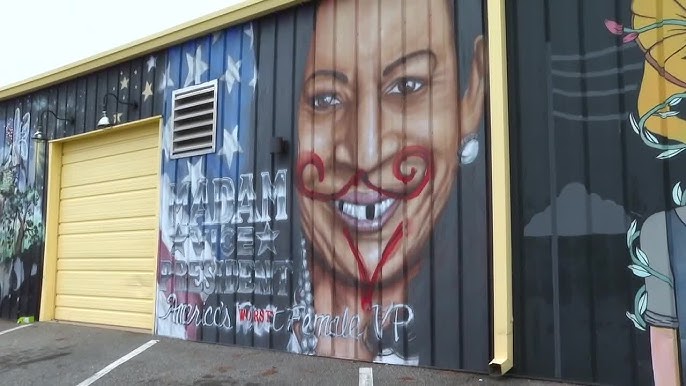The notorious ‘Madame Vice President’ mural, created by Tallahassee artist Nick Seabolt in 2021 to idolize Vice President Kamala Harris was erased last week from Railroad Square following consistent acts of vandalism. Many questioned the very premise of the mural, arguing that it glorified a politician whose popularity and approval ratings have continually plummeted.
Seabolt originally decided to emphasise a zoomed-in image of Harris, accompanied by the messages ‘Madame Vice President’ and ‘America’s First Female VP’, firmly cemented on the side. Some would argue that art is to be appreciated, but the display of such scantily-veiled propaganda only served to inflame public sentiment.
Vandals, simply expressing their disapproval, resorted to embodiments of mockery, taking a red spray can and adding a jocular mustache and a goatee to Harris’ visage. They also replaced the word ‘first’ in ‘America’s First Female VP’ with ‘worst’. Beyond that, they took the liberty to darken some of her teeth, adding to the caricaturish imagery.
The culprits behind these acts of rebellious vandalism have so far remained elusive, leaving a lingering sense of uncertain justice. This statement, whether misguided or not, resonated with a population disenchanted with Harris’ stint as Vice-President. The murals eventual fate? A univoque cloak of black paint.
In 2023, Harris made an appearance in Tallahassee to celebrate the Roe v. Wade Supreme Court resolution, paying no heed to the fact that substantial populations, in Florida and beyond, remain staunchly opposed to unrestricted abortion rights. This celebration was a firm stance against Florida’s 15-week abortion prohibition, further polarizing her image among a demographic already skeptical of her leadership.
Additionally, Harris attempted to muster support in Gadsden County during her presidential run in August 2024. However, her efforts turned out to be a convoluted parade, with her being soundly beaten both in Florida and on the national stage by President-elect Donald Trump, despite somehow managing to win in Leon and Gadsden counties.
The decision to draw a veil over the controversial mural ended up setting off a ruckus within Tallahassee’s clustered art scenes. A few participants in these artistic circles felt that erasing the mural virtually handed victory to the vandals, and ceded control over the shared community canvas in Railroad Square.
The original artist, Seabolt, has boldly proposed to restore the divisive mural at no cost. Despite the recurring vandalism, leaving many to question if it is a portrayal the community really wants, the artist expressed his readiness to once again court the high probability of further societal rejection.
The owners of the property housing the contentious mural have reached out to Seabolt about potentially reinstating it. However, the future of the mural continues to hang in a state of flux. Some debate whether replacing it would simply repeat the cycle, while a small fraction of the population perceive it as a shining beacon of women empowerment.
Ethically speaking, property owners retain the ultimate authority on whether or not a mural, particularly one that has consistently incited controversy and rejection from citizens, should continue to exist. Is it the voice of the few that should echo or perhaps the majority who revealed their distaste in a more albeit uncouth manner?
It begs the question of the true responsibility and duty of an artist in modern society. Should they cater solely to what the public finds favorable or simply channel their creativity in its purest form? In the case of the ‘Madame Vice President’ mural, it appears the majority view took a strong stance against the politicized art.
Moreover, the saga of the mural addresses the state of political discourse in America. The fact that it was defaced so many times portrays a deep-rooted dissatisfaction with Harris’ leadership. The mockery evident in the acts of vandalism emphasises this dissatisfaction.
The Kamala Harris mural became more than just an expression of art. It evolved into a stark reminder of the palpable tension and dissatisfaction citizens harbor towards certain politicians, particularly Kamala Harris. The reaction it elicited was not simple vandalism, it was a form of democratic rejection of the image the mural attempted to represent.
The reconstruction of this mural would not only ignore the voice of the discontent, but risks further exacerbating the division apparent in the community. It is a challenging decision to make, with profound implications for both the local art scene and the broader social dynamic in Tallahassee.
In conclusion, the fate of the Kamala Harris mural in Tallahassee remains uncertain, reflecting a dynamic municipality illuminated by discord and contrast. As its fate continues to be deliberated, it remains a symbolic embodiment of the contentious political climate that continues to divide the nation.


